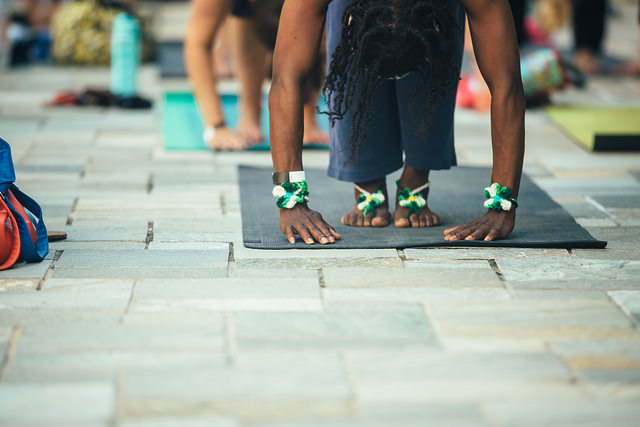Whether we are moving from chaturaga to up-dog or simply stepping to the front of our mats, we, as a whole seem to have forgotten how crucial the act of transitioning truly is with in our practice and even off our mats.
In a day and age when faster, harder and more intense seems to be the priority in most standard yoga classes, the artful process of transitions has slowly but surely gotten lost in the mists of disconnect; this loss is a true shame.
Because transitions are the very joints of our practice, they are what marries movement into a number of asanas without breaking the fluid nature of breath that is supposed to carry us as we consciously move through our mats in an effort to be present, to heal, to shift our perspective and ultimately to change our reality form the inside out.
So why have we forgotten the power behind these moments?
Why have we ignored or obliterated the transitions in our practice?
From personal observations and experiences even with in my own practice I can speak to the fact that often times, bypassing a transition is simply a means to increase our speed—after all, one can’t truly be expected to pull a full count of breath between down-dog and vira-I right? I mean, then the person next to us may rise sooner than us and we can’t have that. Can we?
At other times it is a simple lack of awareness, or it could also be a subconscious indicator that we fear change within our daily lives, or even simpler still, we may never have been taught how important a transition truly is within our yoga practice.
I know I never paid transitions any mind until I broke my toe about four years ago. Like so many of us, I was obsessed with moving faster, harder and more intensely through my practice because in some ways, it meant I was good enough (a story that I have been healing over the past 10-plus years and that can sometimes still take over if I am in complete disconnect) and that terrified me to my very core.
Well, the universe was plotting to teach me a lesson on transitions and it managed to break my toe as a means to that very end. Now, at this point you may be thinking that I moved from one pose into the next, bashed my toe up good and broke my toe. Well, if this is your guess, you are absolutely wrong. Nope, the universe was not going to make it easy for me to figure out where my lack of awareness resided. Instead, it was going to give me a subtle hint in the middle of the night as I made my way back to bed with my puppy in my arms.
On this night, I was in a stormy mood and I decided my little pup was taking too long to get to the bedroom, so I turned off all the lights (yeah, because moving around in utter darkness was a great idea) picked my lovely puppy up in my arms, turned around, took three steps and slammed my toe into the metal leg of my recliner. Yep, ouch. I can tell you it was a miracle I didn’t drop my pup but instead I held her tighter and hobbled with her still in my arms over to the bed where I promptly collapsed and proceeded to freak out as I realized my third toe was pointing in the wrong direction.
I will not bore you with details of doctors and crutches, I will simply cut to the chase and say that in that moment I had no idea what particular lesson was being thrust upon me in such a crushing manner, but I knew that at the very least, I needed to learn to slow down and even take some time off.
So, I reluctantly took two days off and then proceeded to get right back on my mat (some lessons are harder to learn than others).
However, since I couldn’t use my toes as support for almost any pose, I had to find little ways to accommodate my injury while still moving through my practice at an agreeable tempo (in other words, I was trying hard not to have to bring out my bolster for a restorative class). And little by little I realized that the more I slowed down and paid close attention to every part of my body as I moved from one pose to the next, the stronger I was becoming and the more steady my breath and mind became.
Up until this point in my practice, I had never truly understood the power behind a slow, deliberate and aware movement.
Sure, I could take my time in moving from pose to pose but was I really paying attention to each muscle, tendon and bone being used to do something as seemingly simple as stepping my foot back to come into a lunge? Not really, in fact, not at all. I had simply been taking steps, moving arms, dipping, swooping and moving through my mat in a completely ungrounded manner.
I had been reaching and lengthening and following cues to hop to or from this or that place or pose with out the slightest awareness of what my body was doing. I was, in essence, not practicing consciously and therefore, I was not learning to be in the present moment but to live in a state of anticipation and strain.
With my mind constantly on the next move, I was ignoring the true power of each transitional space and the pose directly behind it and I was simply figuring out how to get to the next pose and this was damaging my body and depleting my practice. Now, could I have gone on practicing in this manner with out causing any tangible harm to myself? Sure—I did it for years and many of us have been doing it and will continue doing it with out even realizing it. But the truth of the matter is that the mere act of slowly becoming present to each movement, each point in time and even each part of the body as it moved fluidly from one point in space to the next, took me even further out of ego (which is always humbling) and deeper into my truest self.
Off our mats, we see this lack of awareness through a transitional space reflected by those moments when we slam our elbows, knees, hips or heads into things because we were not paying attention as we moved hither and thither. We can also see this lack of awareness show up when we have forced ourselves out of an emotion simply because we do not want to feel or deal with whatever issue is at hand at any given moment in time.
These painful, difficult, uncomfortable moments are not there to torture us but rather to teach us how to grow into our own power and further develop a sense of self. But many of us refuse to plunge into the discomfort of transition and we wind up bypassing these spaces altogether by anticipating, judging or simply disengaging.
Take for example the death of a loved one, which is clearly a heart-breaking transitional stage, and which we can chose to simply disengage from, become stuck with or plunge deep with in. We can choose to move with an open heart and an active willingness to surrender into the vulnerability of these transitional spaces, or we can choose to bypass them or even become enslaved by them. Either way, that transition is real and it is not disappearing simply because we have not learned how to use the transition as an empowering or healing tool.
On our mats, when we notice every detail, the whole practice becomes a fiery array of energetic and vibrational fluidity that has the potential to shift our perspectives forever. The simple act of noticing what goes into actually stepping my foot to the top of the mat takes considerable effort. So no, being in a state of transitional awareness is not easy, but rather necessary—but it is so rewarding when we finally land and then begin setting up the foundation of our pose in order to better serve our bodies and minds. We are then able to fully harness the healing power within our practice.
Each moment is an invaluable gem and each transition, whether it is lifting our arms up to the skies or rolling forward into a plank pose or even learning how to deal with our emotions on and off the mat is an opportunity to go deeper, to re-learn our bodies, to truly build an anatomically safe pose and to slow our minds down so that we may truly enter that state of meditative awareness for which we have set up a practice to begin with.
So take a moment in your practice to truly appreciate the transitional spaces in between each pose.
Perhaps slow your practice down 10-fold so that you can notice how the body needs to move in order to unwind into child’s pose, and then linger in your chaturanga for more than one clipped breath so that you may remember what this pose feels like. Take your time to lift up, move through or place anything at any given time within your practice and notice how much stronger your inner awareness will become.
I can promise you this: if you learn to savor each transitional moment on your mat, the moments of change within our daily lives will no longer be something horrid we want to run away from or wallow with in, but rather key points in time through which we can further heal, develop and ultimately grow. For it is in these moments that true presence exists and within this presence, a grounded healer will blossom like the lotus flower moves through the murk.
Author: Sapha Arias
Editor: Catherine Monkman
Photo: CityofStPete/Flickr







Read 2 comments and reply